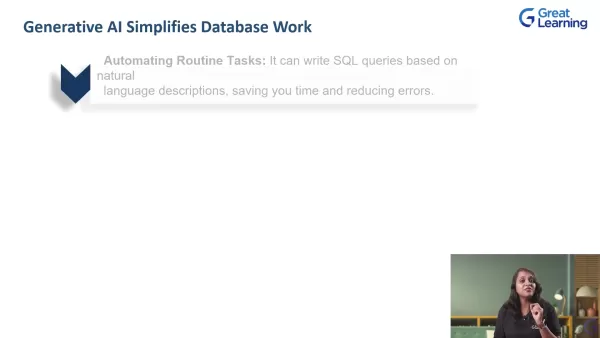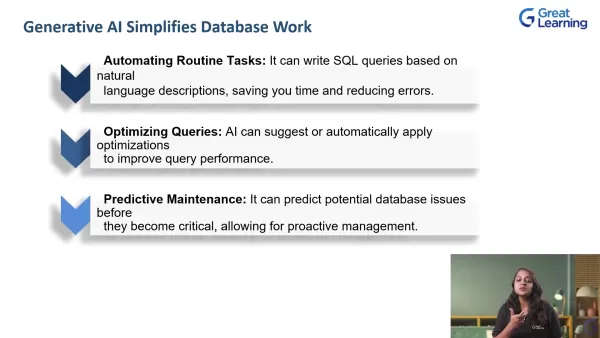AI-Powered SQL Management: Streamline Databases in 2025
Artificial intelligence is transforming database management with SQL, introducing innovative tools that enhance automation and efficiency. By understanding data contexts, offering smart recommendations, automating repetitive tasks, and anticipating issues, AI simplifies SQL operations. This guide explores how AI-driven solutions boost efficiency, precision, and proactive database management.
Key Points
AI automates SQL query creation from natural language inputs, saving time and minimizing errors.
AI enhances query performance by suggesting or applying optimizations automatically.
AI predicts potential database issues, enabling proactive solutions.
AI-driven tools improve productivity and accuracy in database management.
AI makes database operations more user-friendly and efficient.
Understanding AI in SQL
What is AI in SQL?
AI in SQL leverages artificial intelligence to streamline and enhance SQL query creation and database management.

Unlike traditional methods requiring manual coding, AI automates routine tasks, interprets data contexts, offers intelligent recommendations, and prevents issues before they escalate.
This technology is gaining momentum across fields like programming and content creation. AI in SQL marks a significant shift, learning from vast datasets to produce contextually relevant SQL code, from simple queries to complex optimizations, all driven by natural language inputs.
At its core, AI in SQL simplifies database tasks, making them accessible to users of all skill levels. Whether you're an experienced administrator or a beginner, AI tools reduce the effort needed for effective database management. Beyond convenience, AI enhances accuracy, boosts efficiency, and supports proactive strategies.
Integrating AI into SQL management reduces manual work, lowers error risks, and increases productivity through automation. By offering smart recommendations and optimizing queries, AI enables users to create efficient queries and manage databases effectively.
AI is revolutionizing database interactions, turning complex systems into intuitive tools accessible to all. Its ability to interpret contexts, provide smart suggestions, and predict issues enhances efficiency and accessibility.
How AI Simplifies Database Work
Automating Routine Tasks
AI's ability to automate repetitive tasks, especially SQL query writing, is a major advantage.

Users can describe their needs in natural language, and AI generates precise SQL code accordingly.
This automation transforms workflows for administrators and developers, reducing time spent on repetitive tasks and freeing resources for strategic priorities. In large organizations managing multiple databases, this is especially valuable.
By automating query creation, AI minimizes human errors. Trained on extensive SQL datasets, it produces reliable, efficient queries from natural language inputs, eliminating hours of debugging complex syntax.
Automation also democratizes database access for non-technical users, who can describe needs in plain language and let AI handle the rest. This empowers users to analyze data independently, streamlining operations and boosting efficiency.
Optimizing Queries
AI excels at optimizing SQL queries for better performance.

AI suggests or automatically applies optimizations to enhance query speed and data retrieval efficiency.
Query optimization, traditionally complex and time-intensive, becomes seamless with AI. It analyzes queries and database schemas, identifies bottlenecks, and recommends improvements like indexing, query rewriting, or table partitioning.
AI can apply these optimizations without manual intervention, ensuring peak query performance regardless of data complexity. Faster queries enable quicker insights, critical for real-time analytics or reporting, while optimized queries reduce resource usage, lowering management costs.
Predictive Maintenance
AI also supports predictive maintenance for databases.

By analyzing historical data, AI identifies patterns signaling potential issues, enabling proactive measures to prevent downtime.
Predictive maintenance is vital for organizations with critical applications. Early detection allows administrators to address issues like resource shortages, query slowdowns, or capacity limits before they impact users.
AI-driven insights help maintain optimal performance, reducing reactive troubleshooting and freeing administrators for strategic tasks. This ensures databases remain reliable and available, minimizing costly outages.
How to Utilize AI in SQL
Step-by-Step Guide
Integrating AI into SQL management involves clear steps for seamless adoption and performance.
Selecting the Right Tool:
- Choose an AI tool compatible with your database environment, considering usability and features. Various tools offer unique strengths tailored to specific needs.
Database Integration:
- Connect the AI tool to your SQL database, configuring permissions and ensuring data compatibility for effective query analysis and optimization.
Natural Language Input:
- Formulate SQL requests in plain English, such as "Show total sales by product category for the past month," instead of writing complex code.
AI Query Generation:
- The AI interprets your request, identifies relevant tables and fields, and generates an optimized SQL query.
Review and Execution:
- Check the generated query for accuracy. Most tools allow review before execution. Run the query to retrieve results once satisfied.
Optimization Suggestions:
- Implement AI-recommended optimizations, such as indexing or query rewriting, to boost performance.
Predictive Maintenance Analysis:
- Use AI to analyze historical data, identifying potential issues early to maintain database health and prevent disruptions.
Following these steps, users can leverage AI to simplify SQL management, enhance productivity, and maintain optimal database performance.
Pricing Models for AI Tools
Overview of Pricing Options
AI tool pricing varies based on features, usage scale, and provider.
- Subscription-Based:
- A monthly or annual fee grants access to the tool, with costs depending on user count, data volume, or query frequency.
- Pay-as-You-Go:
- Charges are based on usage, such as AI requests or data processed, ideal for variable workloads.
- Freemium:
- Free basic access with limited features, with paid upgrades unlocking advanced capabilities and removing restrictions.
Organizations should assess needs, user count, query volume, and optimization complexity to choose the most cost-effective model.
Pros and Cons
Pros
Boosted Efficiency: Accelerates query creation and database tasks.
Improved Accuracy: Minimizes syntax errors with validated code.
Proactive Management: Maintains database health with predictive insights.
Greater Accessibility: Simplifies management for non-expert users.
Enhanced Performance: Optimizes queries for faster data retrieval.
Cons
Initial Costs: Requires upfront investment for tool implementation.
AI Dependency: May reduce manual SQL proficiency over time.
Data Security: Demands robust privacy measures for AI tools.
Limited Customization: AI queries may not fully meet niche needs.
Learning Curve: Users may need time to adapt to AI workflows.
Key Features of AI in SQL
Core Capabilities for Database Management
AI in SQL offers powerful features to simplify and enhance database operations.
- Natural Language Query Creation:
- Generates SQL queries from plain English inputs, removing the need for manual coding.
- Query Optimization:
- Provides smart suggestions and automates optimizations to boost query performance.
- Predictive Maintenance:
- Analyzes historical data to prevent issues, ensuring reliable database performance.
- Task Automation:
- Handles repetitive tasks like indexing and schema management, freeing up resources.
- Error Reduction:
- Generates accurate, validated SQL code from natural language inputs.
These capabilities drive productivity, accuracy, and database reliability, making AI a vital tool for modern management.
Practical Use Cases for AI in SQL
Real-World Applications
AI in SQL is reshaping database management across industries.
- E-commerce:
- Creates reports on sales by product category, enabling data-driven decisions without manual coding.

Analyzes customer behavior, optimizes product placement, and personalizes marketing with automated insights.
- Healthcare:
- Generates queries to identify patient trends, optimize resources, and enhance outcomes.
- Financial Services:
- Automates queries for risk assessment, fraud detection, and compliance, improving efficiency.
- Manufacturing:
- Optimizes production by analyzing equipment performance and predicting maintenance needs.
These applications highlight AI's versatility in transforming data management practices.
Frequently Asked Questions (FAQ)
How does AI enhance SQL query writing?
AI streamlines query writing by converting natural language inputs into optimized SQL code, reducing manual effort and errors.
Can AI predict database issues?
Yes, AI analyzes historical data to detect patterns, enabling proactive issue prevention and minimizing downtime.
Is AI suitable for all database tasks?
AI excels in routine and common tasks but may require manual coding for highly specialized needs.
Related Questions
What are the benefits of AI in SQL?
AI in SQL boosts efficiency by automating tasks, enhances accuracy with validated code, and supports proactive management through predictive analytics, improving overall database performance.
Which industries benefit most from AI in SQL?
E-commerce, healthcare, financial services, and manufacturing leverage AI for tasks like customer analysis, resource optimization, risk assessment, and production efficiency, gaining a competitive edge.
Related article
 From Dot-Com to AI: Lessons for Avoiding Past Tech Pitfalls
During the dot-com boom, appending “.com” to a company’s name could skyrocket its stock price, even without customers, revenue, or a viable business model. Today, the same frenzy surrounds “AI,” with
From Dot-Com to AI: Lessons for Avoiding Past Tech Pitfalls
During the dot-com boom, appending “.com” to a company’s name could skyrocket its stock price, even without customers, revenue, or a viable business model. Today, the same frenzy surrounds “AI,” with
 AI Image Tools Spark Chaos in Attack on Titan Discord
The realm of AI-powered content creation is thrilling yet unpredictable. What unfolds when a group of anime enthusiasts gains access to a cutting-edge AI text-to-image tool? Absolute mayhem! Dive into
AI Image Tools Spark Chaos in Attack on Titan Discord
The realm of AI-powered content creation is thrilling yet unpredictable. What unfolds when a group of anime enthusiasts gains access to a cutting-edge AI text-to-image tool? Absolute mayhem! Dive into
 Optimizing AI Model Selection for Real-World Performance
Businesses must ensure their application-driving AI models perform effectively in real-world scenarios. Predicting these scenarios can be challenging, complicating evaluations. The updated RewardBench
Comments (0)
0/200
Optimizing AI Model Selection for Real-World Performance
Businesses must ensure their application-driving AI models perform effectively in real-world scenarios. Predicting these scenarios can be challenging, complicating evaluations. The updated RewardBench
Comments (0)
0/200
Artificial intelligence is transforming database management with SQL, introducing innovative tools that enhance automation and efficiency. By understanding data contexts, offering smart recommendations, automating repetitive tasks, and anticipating issues, AI simplifies SQL operations. This guide explores how AI-driven solutions boost efficiency, precision, and proactive database management.
Key Points
AI automates SQL query creation from natural language inputs, saving time and minimizing errors.
AI enhances query performance by suggesting or applying optimizations automatically.
AI predicts potential database issues, enabling proactive solutions.
AI-driven tools improve productivity and accuracy in database management.
AI makes database operations more user-friendly and efficient.
Understanding AI in SQL
What is AI in SQL?
AI in SQL leverages artificial intelligence to streamline and enhance SQL query creation and database management.

Unlike traditional methods requiring manual coding, AI automates routine tasks, interprets data contexts, offers intelligent recommendations, and prevents issues before they escalate.
This technology is gaining momentum across fields like programming and content creation. AI in SQL marks a significant shift, learning from vast datasets to produce contextually relevant SQL code, from simple queries to complex optimizations, all driven by natural language inputs.
At its core, AI in SQL simplifies database tasks, making them accessible to users of all skill levels. Whether you're an experienced administrator or a beginner, AI tools reduce the effort needed for effective database management. Beyond convenience, AI enhances accuracy, boosts efficiency, and supports proactive strategies.
Integrating AI into SQL management reduces manual work, lowers error risks, and increases productivity through automation. By offering smart recommendations and optimizing queries, AI enables users to create efficient queries and manage databases effectively.
AI is revolutionizing database interactions, turning complex systems into intuitive tools accessible to all. Its ability to interpret contexts, provide smart suggestions, and predict issues enhances efficiency and accessibility.
How AI Simplifies Database Work
Automating Routine Tasks
AI's ability to automate repetitive tasks, especially SQL query writing, is a major advantage.

Users can describe their needs in natural language, and AI generates precise SQL code accordingly.
This automation transforms workflows for administrators and developers, reducing time spent on repetitive tasks and freeing resources for strategic priorities. In large organizations managing multiple databases, this is especially valuable.
By automating query creation, AI minimizes human errors. Trained on extensive SQL datasets, it produces reliable, efficient queries from natural language inputs, eliminating hours of debugging complex syntax.
Automation also democratizes database access for non-technical users, who can describe needs in plain language and let AI handle the rest. This empowers users to analyze data independently, streamlining operations and boosting efficiency.
Optimizing Queries
AI excels at optimizing SQL queries for better performance.

AI suggests or automatically applies optimizations to enhance query speed and data retrieval efficiency.
Query optimization, traditionally complex and time-intensive, becomes seamless with AI. It analyzes queries and database schemas, identifies bottlenecks, and recommends improvements like indexing, query rewriting, or table partitioning.
AI can apply these optimizations without manual intervention, ensuring peak query performance regardless of data complexity. Faster queries enable quicker insights, critical for real-time analytics or reporting, while optimized queries reduce resource usage, lowering management costs.
Predictive Maintenance
AI also supports predictive maintenance for databases.

By analyzing historical data, AI identifies patterns signaling potential issues, enabling proactive measures to prevent downtime.
Predictive maintenance is vital for organizations with critical applications. Early detection allows administrators to address issues like resource shortages, query slowdowns, or capacity limits before they impact users.
AI-driven insights help maintain optimal performance, reducing reactive troubleshooting and freeing administrators for strategic tasks. This ensures databases remain reliable and available, minimizing costly outages.
How to Utilize AI in SQL
Step-by-Step Guide
Integrating AI into SQL management involves clear steps for seamless adoption and performance.
Selecting the Right Tool:
- Choose an AI tool compatible with your database environment, considering usability and features. Various tools offer unique strengths tailored to specific needs.
Database Integration:
- Connect the AI tool to your SQL database, configuring permissions and ensuring data compatibility for effective query analysis and optimization.
Natural Language Input:
- Formulate SQL requests in plain English, such as "Show total sales by product category for the past month," instead of writing complex code.
AI Query Generation:
- The AI interprets your request, identifies relevant tables and fields, and generates an optimized SQL query.
Review and Execution:
- Check the generated query for accuracy. Most tools allow review before execution. Run the query to retrieve results once satisfied.
Optimization Suggestions:
- Implement AI-recommended optimizations, such as indexing or query rewriting, to boost performance.
Predictive Maintenance Analysis:
- Use AI to analyze historical data, identifying potential issues early to maintain database health and prevent disruptions.
Following these steps, users can leverage AI to simplify SQL management, enhance productivity, and maintain optimal database performance.
Pricing Models for AI Tools
Overview of Pricing Options
AI tool pricing varies based on features, usage scale, and provider.
- Subscription-Based:
- A monthly or annual fee grants access to the tool, with costs depending on user count, data volume, or query frequency.
- Pay-as-You-Go:
- Charges are based on usage, such as AI requests or data processed, ideal for variable workloads.
- Freemium:
- Free basic access with limited features, with paid upgrades unlocking advanced capabilities and removing restrictions.
Organizations should assess needs, user count, query volume, and optimization complexity to choose the most cost-effective model.
Pros and Cons
Pros
Boosted Efficiency: Accelerates query creation and database tasks.
Improved Accuracy: Minimizes syntax errors with validated code.
Proactive Management: Maintains database health with predictive insights.
Greater Accessibility: Simplifies management for non-expert users.
Enhanced Performance: Optimizes queries for faster data retrieval.
Cons
Initial Costs: Requires upfront investment for tool implementation.
AI Dependency: May reduce manual SQL proficiency over time.
Data Security: Demands robust privacy measures for AI tools.
Limited Customization: AI queries may not fully meet niche needs.
Learning Curve: Users may need time to adapt to AI workflows.
Key Features of AI in SQL
Core Capabilities for Database Management
AI in SQL offers powerful features to simplify and enhance database operations.
- Natural Language Query Creation:
- Generates SQL queries from plain English inputs, removing the need for manual coding.
- Query Optimization:
- Provides smart suggestions and automates optimizations to boost query performance.
- Predictive Maintenance:
- Analyzes historical data to prevent issues, ensuring reliable database performance.
- Task Automation:
- Handles repetitive tasks like indexing and schema management, freeing up resources.
- Error Reduction:
- Generates accurate, validated SQL code from natural language inputs.
These capabilities drive productivity, accuracy, and database reliability, making AI a vital tool for modern management.
Practical Use Cases for AI in SQL
Real-World Applications
AI in SQL is reshaping database management across industries.
- E-commerce:
- Creates reports on sales by product category, enabling data-driven decisions without manual coding.

Analyzes customer behavior, optimizes product placement, and personalizes marketing with automated insights.
- Creates reports on sales by product category, enabling data-driven decisions without manual coding.
- Healthcare:
- Generates queries to identify patient trends, optimize resources, and enhance outcomes.
- Financial Services:
- Automates queries for risk assessment, fraud detection, and compliance, improving efficiency.
- Manufacturing:
- Optimizes production by analyzing equipment performance and predicting maintenance needs.
These applications highlight AI's versatility in transforming data management practices.
Frequently Asked Questions (FAQ)
How does AI enhance SQL query writing?
AI streamlines query writing by converting natural language inputs into optimized SQL code, reducing manual effort and errors.
Can AI predict database issues?
Yes, AI analyzes historical data to detect patterns, enabling proactive issue prevention and minimizing downtime.
Is AI suitable for all database tasks?
AI excels in routine and common tasks but may require manual coding for highly specialized needs.
Related Questions
What are the benefits of AI in SQL?
AI in SQL boosts efficiency by automating tasks, enhances accuracy with validated code, and supports proactive management through predictive analytics, improving overall database performance.
Which industries benefit most from AI in SQL?
E-commerce, healthcare, financial services, and manufacturing leverage AI for tasks like customer analysis, resource optimization, risk assessment, and production efficiency, gaining a competitive edge.
 From Dot-Com to AI: Lessons for Avoiding Past Tech Pitfalls
During the dot-com boom, appending “.com” to a company’s name could skyrocket its stock price, even without customers, revenue, or a viable business model. Today, the same frenzy surrounds “AI,” with
From Dot-Com to AI: Lessons for Avoiding Past Tech Pitfalls
During the dot-com boom, appending “.com” to a company’s name could skyrocket its stock price, even without customers, revenue, or a viable business model. Today, the same frenzy surrounds “AI,” with
 AI Image Tools Spark Chaos in Attack on Titan Discord
The realm of AI-powered content creation is thrilling yet unpredictable. What unfolds when a group of anime enthusiasts gains access to a cutting-edge AI text-to-image tool? Absolute mayhem! Dive into
AI Image Tools Spark Chaos in Attack on Titan Discord
The realm of AI-powered content creation is thrilling yet unpredictable. What unfolds when a group of anime enthusiasts gains access to a cutting-edge AI text-to-image tool? Absolute mayhem! Dive into
 Optimizing AI Model Selection for Real-World Performance
Businesses must ensure their application-driving AI models perform effectively in real-world scenarios. Predicting these scenarios can be challenging, complicating evaluations. The updated RewardBench
Optimizing AI Model Selection for Real-World Performance
Businesses must ensure their application-driving AI models perform effectively in real-world scenarios. Predicting these scenarios can be challenging, complicating evaluations. The updated RewardBench





























